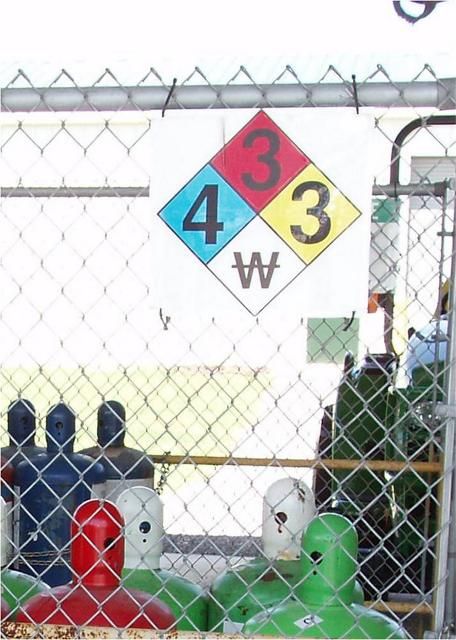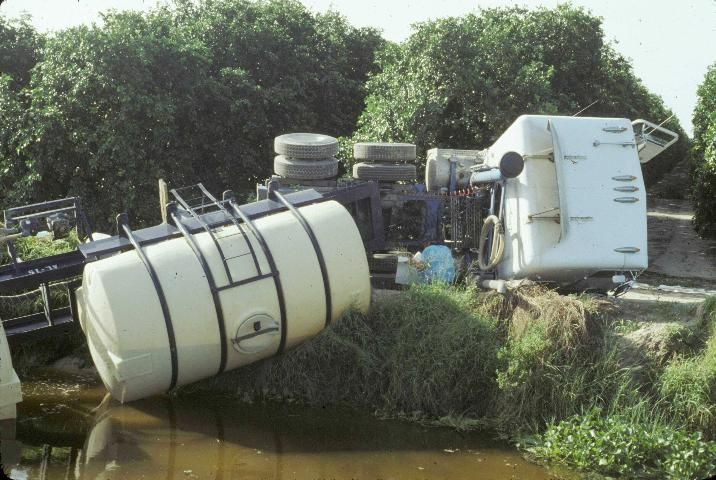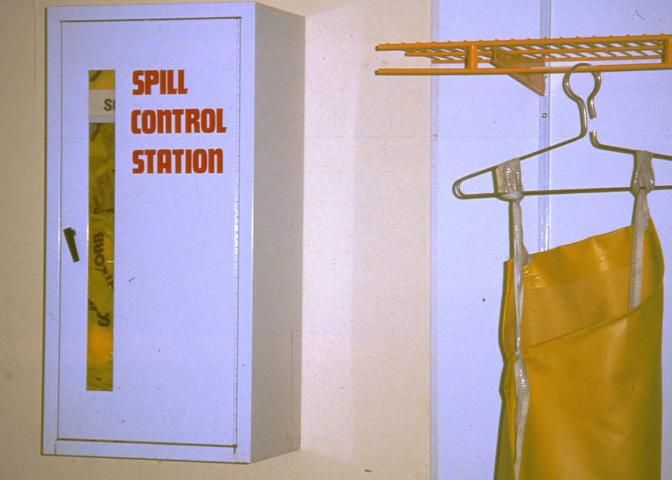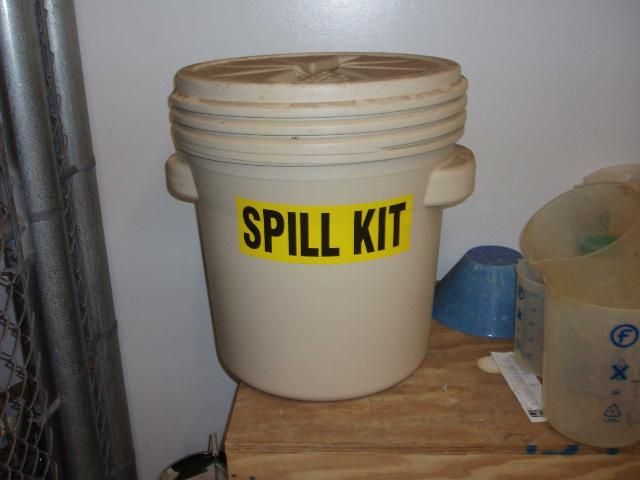This document discusses emergencies which involve pesticide fires and spills.
Although accidents and emergencies involving pesticides are rare, unfortunately they do occur. Many pesticide accidents can be traced to applicator carelessness or misuse. Pesticide accidents or fires can result in water, soil, and air contamination; damage to plants; injury to livestock, wildlife, or pets; and can endanger the health of the applicator and other people. In addition, financial losses can occur from cleanup costs, liability claims, fines, and penalties.
Manufacturers, transporters, dealers, and users of pesticides must treat all pesticide leaks, spills, and fires as emergencies and be prepared to respond to these emergencies promptly and correctly. Do all that you can to prevent accidents, but be prepared in case an emergency should occur.
Pesticide Fires
Fires pose a special hazard in pesticide storage facilities. In addition to the danger of the fire itself, there are also many dangers associated with the flammability of the pesticides stored in the facility. Pesticide products vary significantly in their flammability and the related hazard they pose in storage. Flammable pesticides typically include the following precaution on the label: "Do not use or store near heat or open flame." These warnings will be found in the "Physical and Chemical Hazards" statements on the product's label. Pesticides containing oils or petroleum solvents are the most flammable and are likely to have these warnings, although certain dry formulations also present fire and explosion hazards.
A number of potential problems may be associated with pesticide fires:
- The pesticides may be highly flammable or explosive.
- The pesticides may give off highly toxic vapors or smoke that may harm firefighters, nearby residents, animals, or plants.
- Pesticide residues will most likely be present in the debris and soil following a fire at a pesticide storage facility.
- Water runoff from the fire site will most likely contain chemicals; some may be highly toxic.
Precautions to Reduce Fire Hazards
Emergency or contingency planning is the cornerstone of a responsible action plan. Coordinate all details for responding to a fire with local emergency-response officials and review them annually, at the least. Proactive measures include the following:
- Locate the storage facility as far as possible from places where people and animals live.
- Locate the storage facility so that any runoff due to a fire or spill will not directly flow to a body of water.
- Carefully create a floor plan of the pesticide storage facility and the immediate surrounding area.
- Keep the storage facility locked at all times.
- Post signs to indicate that pesticides are stored in the facility.
- Store combustible pesticides away from steam lines and other heating systems.
- Do not store glass or pressurized containers in sunlight, where they can concentrate heat and possibly explode or ignite.
- Notify the local fire department of the location and contents of the storage facility.
- Develop an emergency plan and train all workers in its execution.
- Keep a written inventory of the pesticides held in storage and file the list away from the storage facility.
If a Fire Occurs
Prompt and responsible action is essential in the event of a chemical fire. Take the following actions in the event of a chemical fire:
- Evacuate the premises.
- Notify the fire department and inform the firefighters of the nature of the pesticides involved.
- Provide emergency-response personnel with safety data sheets (SDS), which include vital technical and emergency information.
- Keep people away. Establish a security perimeter to discourage onlookers.
- If significant smoke is generated, evacuate all people and animals in the vicinity, especially those downwind.
- Check the Emergency Response Guidebook (ERG) for evacuation zones and use the most restrictive.
- Contain small fires with fog, foam, or dry powder. If only water is available, use it as a fine spray or fog. Use only as much water as absolutely necessary. Do not use water jets because they can break bags and glass containers. If using water to fight pesticide fires, be careful not to spread the contamination to the surrounding area through water runoff.
- Make sure water and spilled chemicals are being contained. For larger fires, consider withdrawing and allowing the fire to burn out. This option is preferred over using water to fight the fire since use of water can lead to widespread environmental contamination. If runoff water cannot be avoided, build dikes to contain the contaminated water.
- Clean equipment and all clothing. All personnel involved should shower after fighting the fire.
National Fire Protection Association (NFPA)
The NFPA Hazard Identification System is a rating system of hazard levels used to assist emergency response personnel. This system uses a diamond-shaped warning symbol. The top, left, and right boxes refer to flammability, health, and instability hazards, respectively, and each contains a rating number from 0 to 4 (Table 1). The bottom box is a warning against the use of water. Some pesticides and their storage sites will be marked with such a warning to alert firefighters not to use water to put out a fire (Figure 1).

Credit: UF/IFAS Pesticide Information Office
Pesticide Spills
A spill is any accidental release of a pesticide. The spill may be a minor one involving only one or a few leaking containers, or it may be a major accident in which a piece of equipment malfunctions and releases its contents or a tank truck or rail car overturns and spills its cargo (Figures 2 and 3). All pesticide users must be thoroughly familiar with the laws and guidelines governing chemical spills. The inability to respond properly to such an emergency, no matter how minor the problem, could seriously endanger public health and environmental quality.

Credit: Mongi Zekri, UF/IFAS

Credit: UF/IFAS Pesticide Information Office
The suggested guidelines in the event of a chemical spill are known as the three Cs:
- CONTROL the spill,
- CONTAIN it, and
- CLEAN it up.
Control the Spill
Take immediate steps to control the release of the products being spilled. If a sprayer has tipped over, if a pesticide is leaking from a damaged tank truck, or if a container on a storage shelf is leaking, do whatever you can to stop the leak or spill at once. For instance, smaller containers can be put into larger containers to prevent further release of the chemical. For larger leaks, try to plug the leak if possible. Outside assistance is often required to control large leaks.
Never expose yourself unnecessarily to leaking chemicals—always wear protective equipment when attempting to control a leak. Make sure you wear at least the minimum PPE listed on the chemical label for the products involved in the spill. Never enter a scene blindly, even if someone is injured; first, make sure you are properly protected.
A cellular phone must be standard equipment on every vehicle transporting pesticides. Have all phone numbers you may possibly need saved in your phone and available at your office. Save the following phone numbers on your cellular phone:
- CHEMTREC (Chemical Transportation Emergency Center): 800 262-8200
- Florida Poison Control Center: 800 222-1222
- Florida Department of Environmental Protection: 850 245-2118
- Florida Department of Agriculture and Consumer Services: 850 617-7997
Alert the state and local police if the spill occurs on a public highway. If the spill involves pesticides regulated as hazardous wastes, contaminants must be disposed of properly, usually by a licensed hazardous waste contractor. Check the product SDS to determine if it is a hazardous waste. In certain cases, it may be necessary to alert the fire department, public health officials, and/or the nearest hospital emergency room. Be sure to have the product label(s) and SDS available for emergency responders.
If the spill is large or dangerous, have someone get help. Do not leave the site unattended. Operators need radio or telephone communication available in the vehicle in case they need to call for assistance. The first contact you make in case of a spill is to your county 911 emergency number, which can help coordinate the emergency response. They will assume command of the cleanup unless they know you are capable of handling the situation. In addition, CHEMTREC provides access to emergency response information and technical assistance from chemical industry experts. They can be reached at 1 800 262-8200 or chemtrec@chemtrec.com.
There is also an emergency telephone number on many product labels and on transportation or shipping papers. These lines are answered 24 hours per day by people who are prepared to handle pesticide emergencies involving the company's products.
Rope off the contaminated area; keep people at least 30 feet away from the spill. Avoid contact with any drift or fumes that may be released. Do not use road flares if you suspect the leaking material is flammable. At times it may be necessary to evacuate people from residences or businesses downwind from the spill (refer to the ERG).
Contain the Spill or Leak
At the same time that the leak is being controlled, contain the already spilled material in as small an area as possible. Do everything possible to keep it from spreading or getting worse. In some situations, you may need to use a shovel or power equipment to construct a dike or dam. The important thing to remember is to not let the spilled material get into any body of water, including storm sewers or drains.
If the chemical contaminates a stream, pond, or any other waterway contact the Florida Department of Environmental Protection (1-800-741-4337). Do not delay in notifying authorities because they must alert downstream users as soon as possible to prevent accidental poisoning of livestock and to avoid contamination of irrigated crops and soil.
You can further contain liquid spills by spreading absorbent materials such as fine sand, vermiculite, clay, or pet litter over the entire spill. Avoid using sawdust or sweeping compounds if the pesticide is a strong oxidizer (see label or SDS) because such a combination presents a possible fire hazard. In addition, nonspecific absorbent materials packed in pillows, tubes, or pads can be placed directly on the spill or used to dike around the spill area. Waste disposal is then simplified because the contaminated pillows, tubes, or pads can be placed into heavy-duty disposal bags without dust or spillage. Keep adding absorbent material to the contaminated area until all the liquid is soaked up.
In the case of dust, wettable powder, or granular spills, you can reduce spreading by lightly misting the material with water or covering the spill using some type of plastic cover. Discard the cover after use. Disposal of all hazardous wastes must be done in strict accordance with state and federal laws.
Clean Up the Spill
Once the spill has been contained, sweep it up and place it in a steel or fiber drum lined with a heavy-duty plastic bag. It may then be necessary to decontaminate or neutralize the area. Use ordinary household bleach in water (approximately 30 percent bleach), hydrated lime, or a commercial decontamination preparation to help neutralize the spill area. Check the SDS to see if there are recommendations for use of specific decontaminants. Remember to wear protective equipment. Do not use bleach and lime together. Work this cleaning material into the spill area using a coarse broom. Then add fresh absorbent material to soak up the now contaminated cleaning solution. Sweep up this material and place it in a plastic bag or drum for disposal. It will be necessary to repeat this procedure several times to ensure that the area has been thoroughly decontaminated.
The only effective way to decontaminate soil saturated with a pesticide is to remove the soil down to the depth of contamination. This contaminated soil is now considered hazardous waste and must be disposed of according to state guidelines. Once the contamination has been removed, cover the area with at least 2 inches of lime or a material recommended by the SDS, and finally, cover the lime with fresh topsoil. Soils contaminated as the result of application errors or minor spills can sometimes be cleaned up by applying activated charcoal to the contaminated surface immediately after the spill or misapplication. The charcoal may adsorb or tie up enough chemical to avoid significant plant injury and long-term contamination. However, application of activated charcoal to areas where large spills have occurred does little to reduce soil contamination and subsequent plant damage.
Clean any vehicles and equipment that were contaminated either as a result of the original accident or during the cleanup and disposal procedures. Before you begin, be sure you are properly clothed and protected to avoid contact with the chemical. Use ordinary household bleach in water (approximately 30 percent bleach) or an alkaline detergent (dishwashing soap) solution to clean your equipment. Do not mix bleach and alkaline detergent together. Equipment such as brooms, leather shoes, and cloth hats cannot be effectively decontaminated and must be discarded. Also, do not save disposable garments and gloves or badly contaminated clothing. As soon as you are finished with the spill and equipment cleanup, wash yourself thoroughly with soap and water. Wash any part of your skin that might have been exposed and always wash your face, neck, hands, and forearms.
For legal protection, it is advisable to keep records of your activities and conversations with regulatory authorities, emergency response personnel, and the general public when dealing with a pesticide spill. Take photographs to document any damage as well as the cleanup process. This is another good reason to have a cellular phone available.
Spill Kits
Most pesticide applicators are likely never to have the need for materials that are used in a pesticide spill cleanup. However, should a spill occur while handling concentrated pesticides, a cleanup kit will be well worth the small investment. Simple spill kits contain
- chemical-resistant gloves;
- chemical-resistant coveralls;
- chemical-resistant boots or foot covers;
- chemical splash goggles;
- respirator;
- temporary hazardous material storage bags, such as heavy duty contractor trash bags;
- absorbent pad for water- or solvent-based chemicals;
- absorbent tube sock (containment snake);
- bentonite/polymer mix paste for plugging leaking containers;
- floor absorbent granules;
- shovel or broom;
- dust pan;
- warning sign.
More elaborate kits intended for larger facilities may also include
- pop-up containment pools (various holding capacities are available);
- weatherproof, incinerable drum rated for hazardous materials.
Spill kit materials may be stored in permanent fixtures or structures (Figure 4) or in portable containers as simple as a 5-gallon bucket (Figure 5). The spill kit/location should be clearly labeled. Containers that may be mounted to the cabs of application equipment are also commercially available.

Credit: UF/IFAS Pesticide Information Office

Credit: UF/IFAS Pesticide Information Office
Spill kits should always be ready to use. To make sure that all of the contents remain available, seal the spill kit with an easily breakable seal. It is recommended to monitor spill kits when other safety checks or inspections are being completed.
Additional Information
Emergency Response Guidebook. 2012. US Department of Transportation Pipeline and Hazardous Materials Safety Administration. http://phmsa.dot.gov/pv_obj_cache/pv_obj_id_7410989F4294AE44A2EBF6A80ADB640BCA8E4200/filename/ERG2012.pdf